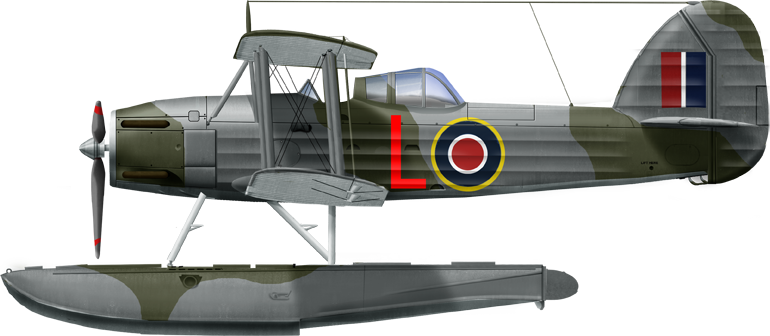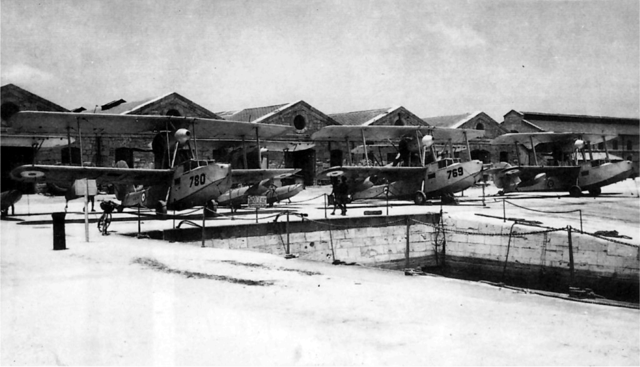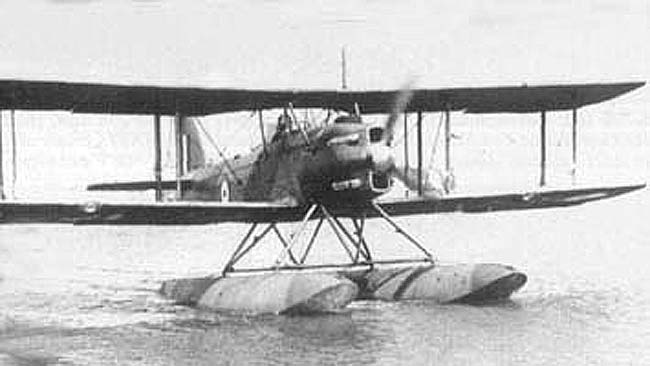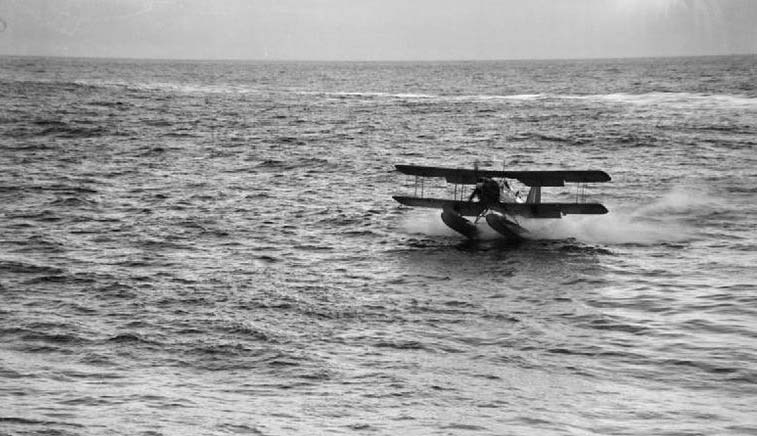The Fairey Seafox was designed and built by Fairey Aviation to be catapulted from light cruisers. It entered service in 1937 and stayed active until 1943 with just 66 produced, in service with 11 naval air squadrons. This biplane was powered as pet an admiralty request by the air-cooled Napier Rapier H engine, and was used both for observation and artillery spotting. Among others it played an important role during the battle of Rio de la Plata between Sturdee's cruisers and KMS Grav Von Spee and from HMS Emerald, Neptune, Orion, Ajax, Arethusa and Penelope, plus the MACs HMS Pretoria Castle, Asturias and Alcantara.
The underbelly was modified and reinforced to ensure proper launching from a catapult and the upper wings received additional bracing for lifting the plane back up with a cargo crane. The monocoque fuselage was all metal, while the wings were covered with canvas.
The model first flew on 27 May 1936 but based on the design already in January 1936, Fairey was awarded the contract, at first for 49 aircraft named "Seafox". The first prototype flew in Hamble in May 1936 and showed already issues with this engine. The second prototype, with the enclose rear coskpit also had a wheeled undercarriage, and took off on November 5, 1936, but was converted into a floatplane afterwards. By September 1936 the order was extended to 15 more aircraft for a total of 66. The 64 were produced quickly, with the first out in 1937, first entering service with the 700 Naval Air Squadron of the Fleet Air Arm, making 66 with the two prototypes. The model was not considered very successful and no further evolution was done.
This was the Rapier VI (E106) which had a decreased supercharging:
-Maximum rating of 295 kW at 4,000 rpm and at 6,000 ft (1,829 m).
-It had a normal rating of 370 hp (276 kW) at 3,650 rpm and 4,750 ft (1,448 m).
-Its takeoff rating was 365 hp (272 kW) at 3,500 rpm and at sea level.
-Fuel consumption at cruise speed was circa .412 lb/hp/hr (251 g/kW/h) at 310 hp (231 kW), 3,500 rpm.
-The engine itself was 56.6 in (1.44 m) long andn 22.4 in (.57 m) wide, 36.0 in (.91 m) tall.
-The engine weighted 713 lb (313 kg).
It was first installed in the Fairey Seafox but early issues were experienced with engine cooling. Despite of this, this the larged use of this model, some seeing used also on the projected Blackburn H.S.T.10 transport in 1936.
Restrospectively, the admiralty decision to go with this engine was a bad one: The limited power meant the Seafox only cruised at 106 mph (171 km/h) and needed time to go on location, and made an easy prey otherwise, and it had a limited range of 440 mi (710 km), divided by two for a return trip. The Seafox in general handled in the air, and at sea, but it was criticised for being underpowered, had a poor cooling (overheating quite a lot), but also higher landing speed that desired.
At the beginning of WWII, the Fleet Air Arm sent fifty Seafoxes on the armed merchant cruisers Orion and Pretoria Castle (later converted as an aircraft carrier), Asturias, and Alcantara.
Also on the light cruisers of the Arethusa class, Arethusa and Penelope, the Leander class HMS Ajax, and the older Emerald.
Catapult Flight maintained one or two planes on board in the 3rd cruiser squadron of the Mediterranean and the 9th cruiser squadron and South American Division (South Atlantic Command). At the start of the conflict, 32 Seafox were at sea with the Royal Navy, Royal Australian Navy and New Zealand Division of the Royal Navy. Seafoxes were not only used by Fleet Air Arm, but the RAN and RNZN, and only these. However some sources report them used by Belgium and Peru, but it is likely some confusion with the Fairey Fox. British seafoxes were kept when ships were transferred, or in Royal Australian Navy Service such as H.M.A.S. Perth, H.M.A.S. Sydney and H.M.A.S. Hobart since the start.
KMS Graf Spee
Soon, it played a in the battle of the Rio de la Plata in December 1939, spotting the German pocket battleship Admiral Graf Spee (Deutschland class) after some scouting and hlping British naval gunners to score many hits. Captain Hans Wilhelm Langsdorff even noted the inability of his AA tpo deal with them during the battle against HMS Exeter, Ajax and Achilles.
Two Seafox were carried, one for HMS Ajax and one for HMS Achilles. Their first use in that pre-radar time, was to search for, and ultimately locate the German pocket battleship Graf Spee which was causing mayhem in the South Atlantic as commerce raider.
The German ship was reported in the estuary of the Rio de Plata river and on December 13, 1939 a fierce fight of several hours followed, during which the two Seafixes remained in the air as long as they could for artillery spotting, ensuring all three cruisers had the upper hand despite all odds. The best cruiser was HMS Exeter with six 8-in guns, versus six 280 mm guns for the Graf Spee. The two light cruisers were armed each with eight 6-in but had to close, which was dangerous in such good weather and calm sea, a textbook naval gunnery setting.
Damaged, Graf Spee was forced to enter Montevideo, Uruguay. And Ajax went on catapulting its Seafox for photo reconnaissance above the Uruguayan arsenal. The observer carried a small camera and the pilot was at low altitude but was forced to face fire from the local AA, neutrality obliged. The Seafox returned with holes of Uruguayan steel. However with the eagerness of the Allied diplomats, KMS Graf Spee was forced to leave on December 17, and famously scuttled at sea, her bruning wrecked being shot by a Seafox from HMS Cumberland, arrived a few hours earlier. Lieutenant Lewin, who spotted the Graf Spee in the first place became the first Fleet Air Arm officer to receive the Victorian Cross in his lifetime. His carrer went on with the Fairey Barracuda.
Mondey, David. The Hamlyn Concise Guide to British Aircraft of World War II. London; New York: Aerospace Publishing Ltd.
Sturtivant, Ray and Balance, Theo. The Squadrons of the Fleet Air Arm. Tonbridge, Kent, UK: Air Britain (Historians) Ltd.
Taylor, H.A. Fairey Aircraft since 1915. London: Putnam, 1974.
http://aviadejavu.ru/Site/Crafts/Craft26189.htm
https://oldmachinepress.com/2020/08/20/napier-h-16-rapier-aircraft-engine/
https://www.militaryfactory.com/aircraft/detail.php?aircraft_id=1386
http://jnpassieux.fr/www/html/Seafox.php
https://www.scalemates.com/topics/topic.php?id=1672
http://www.airwar.ru/enc/sww2/sfox.html
https://www.avionslegendaires.net/avion-militaire/fairey-seafox/
https://encyclopedie-des-armes.com/index.php/aviation/hydravions/1273-fairey-seafox
Kites, Birds & Stuff - FAIREY Aircraft By P.D. Stemp

Main query on scalemates.
This model had been covered by Matchbox to 1/72, there was an old kit from CMA at 1/48. 1/72 also for Formaplane, Revell, and even 1:700 for Flyhawk.
See a kit review (in german)
Design development
In response to the terms a Specification Air Ministry Specification S.I 1/32 for the Royal Navy (the latter did not have the right to publish such specs for aircraft) about a catapult-launched model from battleships at first, later to Cruisers. Fairey applied for the specification and presented a two-seat biplane floatplane, based on previous designs. The pilot was placed in an open cockpit behind a windshield, however the observer-gunner, open in the first prototype, was in a rear enclosed cockpit on the second, which was a novelty, adopted for production.The underbelly was modified and reinforced to ensure proper launching from a catapult and the upper wings received additional bracing for lifting the plane back up with a cargo crane. The monocoque fuselage was all metal, while the wings were covered with canvas.
The model first flew on 27 May 1936 but based on the design already in January 1936, Fairey was awarded the contract, at first for 49 aircraft named "Seafox". The first prototype flew in Hamble in May 1936 and showed already issues with this engine. The second prototype, with the enclose rear coskpit also had a wheeled undercarriage, and took off on November 5, 1936, but was converted into a floatplane afterwards. By September 1936 the order was extended to 15 more aircraft for a total of 66. The 64 were produced quickly, with the first out in 1937, first entering service with the 700 Naval Air Squadron of the Fleet Air Arm, making 66 with the two prototypes. The model was not considered very successful and no further evolution was done.
General conception
The fuselage was of all-metal monocoque construction. The aft part was made of metal longerons covered by fabric, with a metal back. The wings were made of metal spars and ribs covered with fabric, whereas this was full metal on the leading edge. The wings were attached between themselves with two sets of "H" struts each, plus the usual ailerons struts. They were attached to the fuselage with two "V" struts and two poles. The floats were attached to the wings and fuselage by two sets of "W" type struts. The wings had a light dihedral and were symmetrical top to bottom. Both them and the tailwings were of a relatively squarish, straight design.Engine
The Seafox was originally designed for a 500 hp Bristol Aquila radial engine. This was a sturdy and reliable model, but the admiralty wanted to impose instead an inline engine, con,sidered more appropriate to greater speeds and were considered more advanced. Therefore they imposed the Napier Rapier, a 16-cylinder air-cooled H-engine which was rated for 395 hp.This was the Rapier VI (E106) which had a decreased supercharging:
-Maximum rating of 295 kW at 4,000 rpm and at 6,000 ft (1,829 m).
-It had a normal rating of 370 hp (276 kW) at 3,650 rpm and 4,750 ft (1,448 m).
-Its takeoff rating was 365 hp (272 kW) at 3,500 rpm and at sea level.
-Fuel consumption at cruise speed was circa .412 lb/hp/hr (251 g/kW/h) at 310 hp (231 kW), 3,500 rpm.
-The engine itself was 56.6 in (1.44 m) long andn 22.4 in (.57 m) wide, 36.0 in (.91 m) tall.
-The engine weighted 713 lb (313 kg).
It was first installed in the Fairey Seafox but early issues were experienced with engine cooling. Despite of this, this the larged use of this model, some seeing used also on the projected Blackburn H.S.T.10 transport in 1936.
Restrospectively, the admiralty decision to go with this engine was a bad one: The limited power meant the Seafox only cruised at 106 mph (171 km/h) and needed time to go on location, and made an easy prey otherwise, and it had a limited range of 440 mi (710 km), divided by two for a return trip. The Seafox in general handled in the air, and at sea, but it was criticised for being underpowered, had a poor cooling (overheating quite a lot), but also higher landing speed that desired.
Armament
The Seafox was not an offensive model and given its weak engine, could only carrying defensive armament, and exceptionally some extra payload under the wings: For Machine-guns it had a single 0.303 in (7.7 mm) Vickers light machine gun on a flexible mount for the observer. For Bombs: It carried two under-wing racks, each able to carry a single 100 lb (45 kg) bomb, and eight × 20 lb (9.1 kg) incendiary bombs.Production
Production Seafox started to roll off the assembly line in 1937 with deliveries starting from 23 April (K8569 à K8617 et L4519 à L4533). Deliveries stopped with the last delivered in 1938 (unknown date). Catapult tests were carried out by the British Aviation Research Institute, and at sea from HMS Neptune in the Strait of Gibraltar.Specifications Seal Mark I | |
| Crew: | 3: Pilot, Gunner, Observer |
| Dimensions: | 33 ft 8 in x 45 ft 9 in x 12 ft 9 in (10.26 m x 13.94 m x 3.89 m) |
| Wing area: | 443.5 sq ft (41.20 m2) |
| Weight: Light | 6,000 lb (2,722 kg) |
| Propulsion: | Armstrong Siddeley Panther IIA 14-cyl. air-cooled radial 525 hp (391 kW) |
| Performances: | Top speed: 138 mph (222 km/h, 120 kn) Service ceiling: 17,000 ft (5,200 m) Rate of climb: 5,000 ft (1,524 m) in 5 minutes 20 seconds |
| Endurance: | 2 hours 30 minutes |
| Armament - MGs | 1x .303 cal (7.7 mm) aft |
| Armament - Bombs | 316 lb (160 kg) |
Royal Navy service
All units were complete in late 1938. They served with the 700, 702, 703, 713, 714, 716, 718, 754, 764, 765, 773 Naval Air Squadrons. Each corresponded to a single ship, with usually three planes, one anboard, one reserve, and one for training. Some had shared planes. Training Squadrons were 753 et 754.At the beginning of WWII, the Fleet Air Arm sent fifty Seafoxes on the armed merchant cruisers Orion and Pretoria Castle (later converted as an aircraft carrier), Asturias, and Alcantara.
Also on the light cruisers of the Arethusa class, Arethusa and Penelope, the Leander class HMS Ajax, and the older Emerald.
Catapult Flight maintained one or two planes on board in the 3rd cruiser squadron of the Mediterranean and the 9th cruiser squadron and South American Division (South Atlantic Command). At the start of the conflict, 32 Seafox were at sea with the Royal Navy, Royal Australian Navy and New Zealand Division of the Royal Navy. Seafoxes were not only used by Fleet Air Arm, but the RAN and RNZN, and only these. However some sources report them used by Belgium and Peru, but it is likely some confusion with the Fairey Fox. British seafoxes were kept when ships were transferred, or in Royal Australian Navy Service such as H.M.A.S. Perth, H.M.A.S. Sydney and H.M.A.S. Hobart since the start.
Battle of Rio de la Plata

KMS Graf Spee
Soon, it played a in the battle of the Rio de la Plata in December 1939, spotting the German pocket battleship Admiral Graf Spee (Deutschland class) after some scouting and hlping British naval gunners to score many hits. Captain Hans Wilhelm Langsdorff even noted the inability of his AA tpo deal with them during the battle against HMS Exeter, Ajax and Achilles.
Two Seafox were carried, one for HMS Ajax and one for HMS Achilles. Their first use in that pre-radar time, was to search for, and ultimately locate the German pocket battleship Graf Spee which was causing mayhem in the South Atlantic as commerce raider.
The German ship was reported in the estuary of the Rio de Plata river and on December 13, 1939 a fierce fight of several hours followed, during which the two Seafixes remained in the air as long as they could for artillery spotting, ensuring all three cruisers had the upper hand despite all odds. The best cruiser was HMS Exeter with six 8-in guns, versus six 280 mm guns for the Graf Spee. The two light cruisers were armed each with eight 6-in but had to close, which was dangerous in such good weather and calm sea, a textbook naval gunnery setting.
Damaged, Graf Spee was forced to enter Montevideo, Uruguay. And Ajax went on catapulting its Seafox for photo reconnaissance above the Uruguayan arsenal. The observer carried a small camera and the pilot was at low altitude but was forced to face fire from the local AA, neutrality obliged. The Seafox returned with holes of Uruguayan steel. However with the eagerness of the Allied diplomats, KMS Graf Spee was forced to leave on December 17, and famously scuttled at sea, her bruning wrecked being shot by a Seafox from HMS Cumberland, arrived a few hours earlier. Lieutenant Lewin, who spotted the Graf Spee in the first place became the first Fleet Air Arm officer to receive the Victorian Cross in his lifetime. His carrer went on with the Fairey Barracuda.
Some Seafoxes used until ...1945
These seaplanes were withdrawn after 1942, some retained for pilot training until withdrawal in turn from July 1943, but the very last in July 1945. They were gradually replaced by the Vought Kingfisher, a great improvement all around. Most of the pilots and observers of Seafox therefore joined the Kingfisher except for some crews of Squadron 753 who subsequently flew on Swordfish. Some Seafoxes of 716 Squadron remained in service until February 1944 for the surveillance of British port installations in the Irish Sea. It was one of these that spotted a U-boat off Liverpool in November 1943, chased by two FAA Avengers and sank after three hours.Links and resources
Books
"For Light Reconnaissance" (PDF). Flight, 9 December 1937.Mondey, David. The Hamlyn Concise Guide to British Aircraft of World War II. London; New York: Aerospace Publishing Ltd.
Sturtivant, Ray and Balance, Theo. The Squadrons of the Fleet Air Arm. Tonbridge, Kent, UK: Air Britain (Historians) Ltd.
Taylor, H.A. Fairey Aircraft since 1915. London: Putnam, 1974.
Links
https://en.wikipedia.org/wiki/Fairey_Seafoxhttp://aviadejavu.ru/Site/Crafts/Craft26189.htm
https://oldmachinepress.com/2020/08/20/napier-h-16-rapier-aircraft-engine/
https://www.militaryfactory.com/aircraft/detail.php?aircraft_id=1386
http://jnpassieux.fr/www/html/Seafox.php
https://www.scalemates.com/topics/topic.php?id=1672
http://www.airwar.ru/enc/sww2/sfox.html
https://www.avionslegendaires.net/avion-militaire/fairey-seafox/
https://encyclopedie-des-armes.com/index.php/aviation/hydravions/1273-fairey-seafox
Kites, Birds & Stuff - FAIREY Aircraft By P.D. Stemp
The model corner

Main query on scalemates.
This model had been covered by Matchbox to 1/72, there was an old kit from CMA at 1/48. 1/72 also for Formaplane, Revell, and even 1:700 for Flyhawk.
See a kit review (in german)
Gallery
Author's illustrations: Types and liveries

Seafox Mark I of 765 Naval Air Station, Seaplane school Lee-on-Solent, 1939

Seafox onboard HMS Arethusa, 713 Catapulted Flight, Kalafrana, Malta 1939

Seafox Mark I from 702 Sqn. FAA, MAC HMS Asturias, 1942
Additional photos




- Lohner E (1913)
- Macchi M3 (1916)
- Macchi M5 (1918)
- Ansaldo ISVA (1918)
- Sopwith Baby (1916)
- Short 184 (1916)
- Fairey Campania (1917)
- Sopwith Cuckoo (1917)
- Felixstowe F.2 (1917)
- Friedrichshafen FF 33 (1916)
- Albatros W4 (1916)
- Albatros W8 (1918)
- Hanriot HD.2
- Grigorovitch M5
- IJN Farman MF.7
- IJN Yokosho Type Mo
- Yokosho Rogou Kougata (1917)
- Yokosuka Igo-Ko (1920)
- Curtiss N9 (1916)
- Aeromarine 39
- Vought VE-7
- Douglas DT (1921)
- Boeing FB.5 (1923)
- Boeing F4B (1928)
- Vought O2U/O3U Corsair (1928)
- Blackburn Blackburn (1922)
- Supermarine Seagull (1922)
- Blackburn Ripon (1926)
- Fairey IIIF (1927)
- Fairey Seal (1930)
- LGL-32 C.1 (1927)
- Caspar U1 (1921)
- Dornier Do J Wal (1922)
- Rohrbach R-III (1924)
- Mitsubishi 1MF (1923)
- Mitsubishi B1M (1923)
- Yokosuka E1Y (1923)
- Nakajima A1N (1927)
- Nakajima E2N (1927)
- Mitsubishi B2M (1927)
- Nakajima A4N (1929)
- CANT 18
WW1
✠ K.u.K. Seefliegerkorps:
 Italian Naval Aviation
Italian Naval Aviation
 RNAS
RNAS
 Marineflieger
Marineflieger
 French Naval Aviation
French Naval Aviation
 Russian Naval Aviation
Russian Naval Aviation
 IJN Air Service
IJN Air Service
 USA
USA
Interwar
 Interwar US
Interwar US
 Interwar Britain
Interwar Britain
 Interwar France
Interwar France
 Interwar Germany
Interwar Germany
 Interwar Japan
Interwar Japan
 Interwar Italy
Interwar Italy
- Curtiss SOC seagull (1934)
- Grumman FF (1931)
- Curtiss F11C Goshawk (1932)
- Grumman F2F (1933)
- Grumman F3F (1935)
- Northrop BT-1 (1935)
- Grumman J2F Duck (1936)
- Consolidated PBY Catalina (1935)
- Brewster/NAF SBN-1 (1936)
- Curtiss SBC Helldiver (1936)
- Vought SB2U Vindicator (1936)
- Brewster F2A Buffalo (1937)
- Douglas TBD Devastator (1937)
- Vought Kingfisher (1938)
- Curtiss SO3C Seamew (1939)
- Douglas SBD Dauntless (1939)
- Grumman F4F Wildcat (1940)
- F4U Corsair (NE) (1940)
- Brewster SB2A Buccaneer (1941)
- Grumman TBF/TBM Avenger (1941)
- Consolidated TBY Sea Wolf (1941)
- Grumman F6F Hellcat (1942)
- Curtiss SB2C Helldiver (1942)
- Curtiss SC Seahawk (1944)
- Grumman F8F Bearcat (1944)
- Ryan FR-1 Fireball (1944)
- Douglas AD-1 Skyraider (1945)
Fleet Air Arm
- Fairey Swordfish (1934)
- Blackburn Shark (1934)
- Supermarine Walrus (1936)
- Fairey Seafox (1936)
- Blackburn Skua (1937)
- Short Sunderland (1937)
- Blackburn Roc (1938)
- Fairey Albacore (1940)
- Fairey Fulmar (1940)
- Grumman Martlet (1941)
- Hawker sea Hurricane (1941)
- Brewster Bermuda (1942)
- Fairey Barracuda (1943)
- Fairey Firefly (1943)
- Grumman Tarpon (1943)
- Grumman Gannet (1943)
- Supermarine seafire (1943)
- Blackburn Firebrand (1944)
- Hawker Sea Fury (1944)
IJN aviation
- Aichi D1A "Susie" (1934)
- Mitsubishi A5M "Claude" (1935)
- Nakajima A4N (1935)
- Yokosuka B4Y "Jean" (1935)
- Mitsubishi G3M "Nell" (1935)
- Nakajima E8N "Dave" (1935)
- Kawanishi E7K "Alf" (1935)
- Nakajima B5N "Kate" (1937)
- Kawanishi H6K "Mavis" (1938)
- Aichi D3A "Val" (1940)
- Mitsubishi A6M "zeke" (1940)
- Nakajima E14Y "Glen" (1941)
- Nakajima B6N "Jill" (1941)
- Mitsubishi F1M "pete" (1941)
- Aichi E13A Reisu "Jake" (1941)
- Kawanishi E15K Shiun "Norm" (1941)
- Nakajima C6N Saiun "Myrt" (1942)
- Yokosuka D4Y "Judy" (1942)
- Kyushu Q1W Tokai "Lorna" (1944)
Luftwaffe
- Arado 196 (1937)
- Me109 T (1938)
- Blohm & Voss 138 Seedrache (1940)
Italian Aviation
- Savoia-Marchetti S.55
- IMAM Ro.43/44
- CANT Z.501 Gabbiano
- CANT Z.506 Airone
- CANT Z.508
- CANT Z.511
French Aeronavale
- GL.300 (1926-39)
- Levasseur PL.5 (1927)
- Potez 452 (1935)
- Loire 210 (1936)
- Loire 130 (1937)
- LN 401 (1938)
Soviet Naval Aviation
- Shavrov SH-2 (1928)
- Tupolev TB-1P (1931)
- Beriev MBR-2 (1930)
- Tupolev MR-6 (1933)
- Tupolev MTB-1 (1934)
- Beriev Be-2 (1936)
- Polikarpov I16 naval (1936)
- Tupolev MTB-2 (1937)
- Ilyushine DB-3T/TP (1937)
- Beriev Be-4 (1940)
-
Skoda Š-328V
R-XIII Idro
Fokker C.XI W (1934)
WW2
- De Havilland Sea Vixen
- Hawker Sea Hawk
- Supermarine Scimitar
- Blackburn Buccaneer
- Hawker Sea Harrier
- Douglas A4 Skyhawk
- Grumman F9F Panther
- Vought F8 Crusader
- McDonnell-Douglas F-4 Phantom-II
- North Am. A5 Vigilante
- TU-142
- Yak 38 forger
☢ Cold War
✧ NATO
 Fleet Air Arm
Fleet Air Arm
 US Navy
US Navy
☭ Warsaw Pact
Merch

Seafire Mark 45; HMS Pretoria Castle

Zeros vs its aversaries

Aichi D3A “Val” Junyo

Mitsubishi A5M poster

F4F wildcat

Macchi M5

SBD Dauntless Coral Sea

SBD Dauntless USS Enterprise

SBD-4 CV22